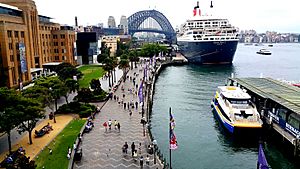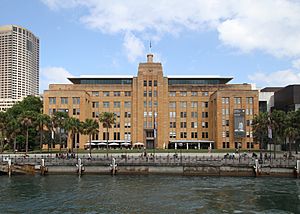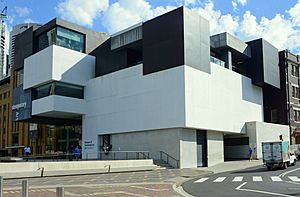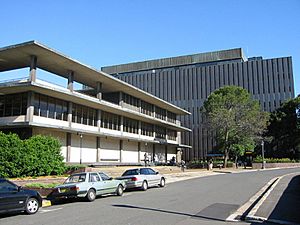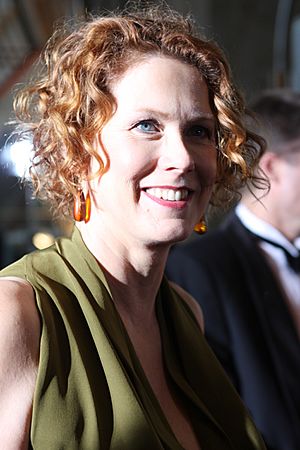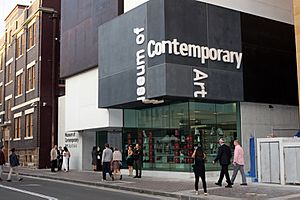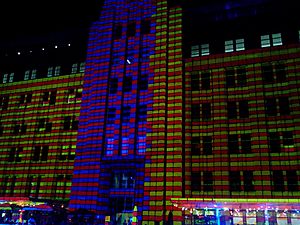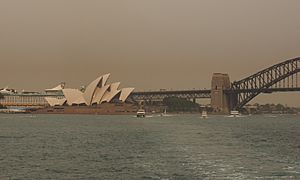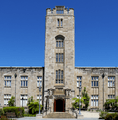Museum of Contemporary Art Australia facts for kids
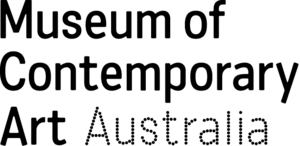 |
|
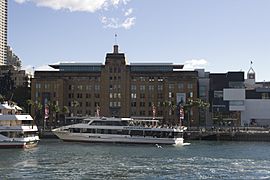
Museum from the east,
with newer Mordant Wing at right. |
|
| Lua error in Module:Location_map at line 420: attempt to index field 'wikibase' (a nil value). | |
| Established | 1991 |
|---|---|
| Location | George Street, Sydney, Australia |
| Type | Contemporary art |
| Collections | Raminging, Maningrida, Arnott's, Smorgon |
| Collection size | 4,500 |
| Visitors | 1,014,021 (2019) 367,849 (2020) |
| Founder | John Power; University of Sydney |
| Architect | William Henry Withers, Andrew Andersons, Sam Marshall |
| Public transit access |
|
The Museum of Contemporary Art Australia (MCA) is a cool place in Sydney's The Rocks area. It's the only museum in Australia that focuses only on contemporary art. This means it shows art made in our time, from Australia and all over the world.
The museum started in 1991, but its story goes back much further. An Australian artist named JW Power wanted a museum for modern art. He left money and his art collection to the University of Sydney in his will in 1943. For many years, his art was shown as a traveling collection.
The museum is in an old, grand building called the Maritime Services Board Building. It's right by Circular Quay. In 2012, a new, modern part called the Mordant Wing was added.
When the museum first opened, it was called the Museum of Contemporary Art, Sydney. It quickly became too small and had money problems. But a new director, Elizabeth Ann Macgregor, helped fix things. She made it free to enter the main museum, which brought in many more visitors. The museum now focuses mostly on Australian contemporary art. It has over 4,000 artworks by Australian artists. These include paintings, photos, sculptures, and works by Aboriginal and Torres Strait Islander artists. The museum also has special programs for young people and people with disabilities.
Contents
Exploring the Museum Building
The Museum of Contemporary Art has two main parts. One is the original Maritime Services Board (MSB) building. The other is the newer Mordant Wing.
Where is the Museum Located?
The museum is right on the waterfront in Sydney's The Rocks neighborhood. George Street is on one side, and Circular Quay is on the other. From the museum, you can see famous landmarks. The Sydney Opera House is nearby across the water. The Sydney Harbour Bridge is also close by.
Cruise ships often dock at the quay. Ferries also come and go from here. This makes the museum easy to reach.
Outside the Museum
The Old Building: Maritime Services Board Building
The original MSB building is six stories tall. It's made of light orange-brown stone. It has a special style called Stripped Classicism with Art Deco designs. There's a clock tower in the middle. Modern glass sections have been added to the top.
The main entrance has dark bronze doors. Above them is a stone carving of sailors and dockworkers. A bronze sign says "Museum of Contemporary Art".
The New Part: Mordant Wing
The Mordant Wing is on the north side of the old building. It's also six stories high. This part looks very modern. It has smooth panels of black, white, and brown stone. These blocks are different shapes and sizes.
The main entrance to the museum is where the new wing meets the old building. It has glass doors and a wide staircase. On the roof of the Mordant Wing, there's a cafe. From here, you get amazing views of the bridge, opera house, and harbor.
Inside the Museum
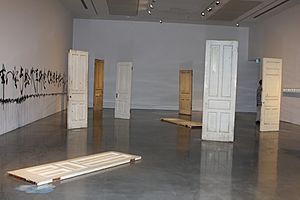
When it was the Maritime Services Board building, the inside had fancy floors and walls that looked like marble. Today, much of the inside is used for art galleries. These spaces have plain white walls, concrete floors, and high ceilings. This design helps the art stand out. Some of the original office spaces are still used for the museum's staff.
Museum History
Early Days: The Site Before the Museum (1798–1942)
The land where the museum stands has a long history. It was once home to two Commissariat Stores. These were built by convicts. In 1937, it was decided to build a new office for the Maritime Services Board (MSB) here.
Construction started in 1939 but stopped during World War II. It began again in 1944. The building officially opened in 1952. It is now a protected heritage site.
How the Museum Started: The Power Gallery (1943–1991)
The idea for the MCA came from JW Power (1881–1943). He was an Australian artist who experimented with Cubism. In his will, he left a lot of money to the University of Sydney. He wanted it used to teach Australians about modern art from other countries.
When Power's wife died in 1961, his gift became public. It was the largest money gift ever to an Australian university for the arts. The university then created the Power Institute of Fine Arts. This led to the 'Power Gallery of Contemporary Art'. It was a collection of art that traveled around. It didn't have a permanent home for many years.
Opening the Museum (1991–1999)
In 1989, the Maritime Services Board moved out of its building. The New South Wales government then gave the building to the Museum of Contemporary Art. The building was fixed up and the Museum of Contemporary Art, Sydney, officially opened in 1991.
The early years were tough. The museum struggled financially. It charged an entry fee, but it wasn't enough. People worried about the museum's future. The building also needed more changes to be a better art gallery. Plans for new designs were made, but they didn't work out.
A New Era: Elizabeth Ann Macgregor (1999–2010)
In 1999, Elizabeth Ann Macgregor became the museum's director. The museum was almost out of money. She had a big impact. To get more visitors, she removed the $12 entry fee. This was possible thanks to a sponsorship from Telstra.
When the museum opened for the 12th Biennale of Sydney in 2000, it was packed. Macgregor said that making it free "completely changed the atmosphere." People came out of curiosity. Within a year, visitor numbers tripled. (Note: There is still a fee for special temporary exhibitions).
Macgregor believed that modern art should be for everyone. She reached out to communities in Greater Western Sydney. The museum even partnered with the Penrith Panthers rugby team. She also made sure that the descriptions of artworks were easy to understand.
The museum's visitor numbers grew a lot. This showed that the old building needed more space. The elevators were old, and it was hard for people with disabilities to get around. The museum needed to expand.
Adding the New Wing (2010–2012)
In 2010, the museum closed for its big expansion. The new part, the Mordant Wing, was designed by Sam Marshall. It was named after Simon Mordant and his wife, who gave a large donation. The total cost was $53 million. Governments and other private donors also helped.
The new wing opened in stages in 2011 and 2012. It added a lot more space for art. It also included a cafe, a sculpture terrace, and new event spaces. These additions helped the museum earn more money. The new wing also connected George Street and Circular Quay for the first time.
The design of the new wing was inspired by sculptures. Its different colored blocks reflect the colors of the surrounding area.
Growing Popularity (2012–2019)
After the new wing opened, visitor numbers soared. In 2012, nearly 850,000 people visited. By 2018, the museum had a record 1.1 million visitors. Many international and young visitors came to the MCA.
Macgregor believed that contemporary art should be for everyone. The museum hired about 84 working artists for its visitor services team. This made the MCA one of the biggest employers of artists in Australia. These artists help make the art easy for everyone to understand.
In 2017, the museum had a very popular exhibition by Pipilotti Rist. Tickets sold out often. The museum even stayed open longer to handle the crowds. By 2019, the MCA was one of the most visited contemporary art museums in the world.
Recent Times: Pandemic and New Leaders (2020–Present)
The high visitor numbers didn't last. First, severe bushfires in 2019 affected tourism. Then, the COVID-19 pandemic hit. The museum had to close for a long time in 2020.
The museum lost a lot of its funding because of the closures. It relied on its donors and government support programs. The MCA also created online programs to keep people engaged. They even produced creative activities for a newspaper supplement for kids without internet access.
In July 2020, Lorraine Tarabay became the new chairperson of the board. In 2021, Elizabeth Ann Macgregor stepped down as director after 22 years. Suzanne Cotter was hired to replace her in July 2021.
How the Museum is Run
The museum gets its money from different places. When the regular entrance fee was removed, the museum made up for it by selling more items in its shops. Donation boxes also helped. After the 2010 renovations, the cafes and renting out spaces in the museum also brought in money.
About 22% of the museum's money comes from government grants. Another 24% comes from private and company donors. The rest comes from things like shop sales, fees for special exhibitions, and other income.
The museum's board sets its direction. It has 11 members. Lorraine Tarabay is the current chair. Suzanne Cotter, the director, leads the museum's staff. They handle everything from choosing art to digital programs.
Art Collections
The museum's main collection grew from the Power Collection. At first, the museum mostly bought international art. But since 2002, it has focused more on Australian artists. It now has over 4,500 artworks.
The Ramingining Collection
This collection has more than 250 artworks. They are by over 80 Yolŋu artists from Ramingining in the Northern Territory. The collection includes bark paintings, woven objects, sculptures, and tools. It was bought in 1984–1985.
The Ramingining Collection has been shown at the MCA several times. It helps people learn about Indigenous art and culture.
The Maningrida Collection
This collection has 560 artworks from the Maningrida community in Arnhem Land. The Maningrida people still own these pieces. The museum has a special agreement with the community. The collection includes sculptures, woven objects, and bark paintings.
The museum works with Indigenous researchers and artists. They learn about and document the objects in the collection. This helps keep a good relationship with the Maningrida people.
The Arnott's Collection
The Arnott family donated 285 bark paintings to the MCA in 1993. This collection is known as the Arnott's Collection. It has been featured in exhibitions.
The Smorgon Collection
The Smorgon Collection was given to the MCA in 1995. It has 149 contemporary Australian artworks from the 1980s and 1990s. A donation from Loti Smorgon helped build a sculpture terrace on the museum's fourth floor. It is now named after her.
Special Art Exhibitions
The MCA hosts many temporary exhibitions. These shows feature famous artists from Australia and around the world. Some past exhibitions include:
- Pipilotti Rist – ‘Sip My Ocean’ (2018)
- Grayson Perry – ‘My Pretty Little Art Career’ (2016)
- Yoko Ono – ‘War is Over! (if you want it)’ (2013)
- Anish Kapoor (2013)
- Yayoi Kusama – ‘Mirrored Years’ (2009)
- Andy Warhol – 'Portraits’ (1994)
Primavera Exhibition
Primavera: The Belinda Jackson Exhibit is Australia's longest-running exhibition. It happens every year since 1992. It shows art by Australian artists who are 35 years old or younger. This gives new artists a chance to show their work in a big museum. Each year, the exhibition has a different theme.
Tate x MCA Collaboration
In 2015, the MCA started working with the Tate Galleries in Britain. This five-year project helps both museums buy contemporary Australian artworks. It aims to make Australian art more famous around the world. They have bought 23 artworks by 16 major Australian artists. Many of these have been shown at both museums.
The National Exhibition
The National is a series of art shows that happen every two years. It features contemporary Australian artists. It's a partnership between the Art Gallery of New South Wales, Carriageworks, and the MCA. The exhibition shows the diverse ideas of Australian artists. It started in 2017 and has happened in 2019 and 2021.
Museum Programs
The Museum of Contemporary Art offers many public programs. These include learning programs for Indigenous people and a special program for people with dementia.
The Bella Program
The Bella program started in 1993. It helps young people, especially those with disabilities or financial challenges, access contemporary art. The program offers gallery sessions and hands-on art workshops.
In 2012, a special Bella Room was created. Each year, a new artist creates a work for this room. It's a sensory space where students can interact with art.
GENEXT
'GENEXT' is a popular program for young people aged 12 to 18. It started in 2005. GENEXT events happen after the museum closes. They include live music, discussions, and art workshops. It's held four times a year. Over 16,000 young people have taken part in its first ten years.
The MCA also works with the Art Gallery of New South Wales for the Sydney Festival and the Biennale of Sydney.
MCA Zine Fair
The annual MCA Zine Fair started in 2008. It's held with the Sydney Writers' Festival. The fair takes place on the museum's front lawn. It features over 50 stalls with zines by new and established artists.
The Artful: Art and Dementia
This program started in 2016. It's a research project that looks at how art can help people with dementia. The program includes tours of the museum and art-making sessions. Participants can also do art at home. The program ends with an exhibition of their artwork. In 2020, an online version was launched.
Images for kids


